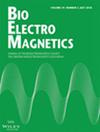Honghong Yang, Yuanyuan Zhang, Xianwen Wu, Ping Gan, Xiaoli Luo, Shixun Zhong, Wenqi Zuo
求助PDF
{"title":"Effects of Acute Exposure to 3500 MHz (5G) Radiofrequency Electromagnetic Radiation on Anxiety-Like Behavior and the Auditory Cortex in Guinea Pigs","authors":"Honghong Yang, Yuanyuan Zhang, Xianwen Wu, Ping Gan, Xiaoli Luo, Shixun Zhong, Wenqi Zuo","doi":"10.1002/bem.22388","DOIUrl":null,"url":null,"abstract":"<p>Numerous studies have shown that radiofrequency electromagnetic radiation (RF-EMR) may negatively affect human health. We detected the effect of 3500 MHz RF-EMR on anxiety-like behavior and the auditory cortex (ACx) in guinea pigs. Forty male guinea pigs were randomly divided into four groups and exposed to a continuous wave of 3500 MHz RF-EMF at an average specific absorption rate (SAR) of 0, 2, 4, or 10 W/kg for 72 h. After exposure, malondialdehyde (MDA) levels, antioxidant enzyme activity, anxiety-like behavior, hearing thresholds, cell ultrastructure, and apoptosis were detected. Our results revealed that hearing thresholds and basic indexes of animal behavior did not change significantly after exposure (<i>P</i> > 0.05). However, the MDA levels of ACx were increased (<i>P</i> < 0.05), and catalase (CAT), superoxide dismutase (SOD), and glutathione peroxidase (GSH-px) activities were decreased (<i>P</i> < 0.05) in the exposure groups compared to the sham group. Ultrastructural changes of ACx, including swollen mitochondria and layered myelin sheaths, were observed. Cytochrome-c relocalization, caspase-9, and cleaved caspase-3 activation were detected in the exposure groups. In conclusion, these results suggest that oxidative stress is an important mechanism underlying the biological effects of RF-EMR, which can induce ultrastructural damage to the ACx and cell apoptosis through a mitochondria-dependent mechanism. Moreover, oxidative stress, apoptosis induction and ultrastructural damage increase in a SAR-dependent manner. However, RF-EMR does not increase hearing thresholds or induce anxiety. Bioelectromagnetics. 43:106–118, 2022. © 2021 Bioelectromagnetics Society.</p>","PeriodicalId":8956,"journal":{"name":"Bioelectromagnetics","volume":"43 2","pages":"106-118"},"PeriodicalIF":1.2000,"publicationDate":"2022-01-23","publicationTypes":"Journal Article","fieldsOfStudy":null,"isOpenAccess":false,"openAccessPdf":"","citationCount":"5","resultStr":null,"platform":"Semanticscholar","paperid":null,"PeriodicalName":"Bioelectromagnetics","FirstCategoryId":"99","ListUrlMain":"https://onlinelibrary.wiley.com/doi/10.1002/bem.22388","RegionNum":3,"RegionCategory":"生物学","ArticlePicture":[],"TitleCN":null,"AbstractTextCN":null,"PMCID":null,"EPubDate":"","PubModel":"","JCR":"Q3","JCRName":"BIOLOGY","Score":null,"Total":0}
引用次数: 5
引用
批量引用
Abstract
Numerous studies have shown that radiofrequency electromagnetic radiation (RF-EMR) may negatively affect human health. We detected the effect of 3500 MHz RF-EMR on anxiety-like behavior and the auditory cortex (ACx) in guinea pigs. Forty male guinea pigs were randomly divided into four groups and exposed to a continuous wave of 3500 MHz RF-EMF at an average specific absorption rate (SAR) of 0, 2, 4, or 10 W/kg for 72 h. After exposure, malondialdehyde (MDA) levels, antioxidant enzyme activity, anxiety-like behavior, hearing thresholds, cell ultrastructure, and apoptosis were detected. Our results revealed that hearing thresholds and basic indexes of animal behavior did not change significantly after exposure (P > 0.05). However, the MDA levels of ACx were increased (P < 0.05), and catalase (CAT), superoxide dismutase (SOD), and glutathione peroxidase (GSH-px) activities were decreased (P < 0.05) in the exposure groups compared to the sham group. Ultrastructural changes of ACx, including swollen mitochondria and layered myelin sheaths, were observed. Cytochrome-c relocalization, caspase-9, and cleaved caspase-3 activation were detected in the exposure groups. In conclusion, these results suggest that oxidative stress is an important mechanism underlying the biological effects of RF-EMR, which can induce ultrastructural damage to the ACx and cell apoptosis through a mitochondria-dependent mechanism. Moreover, oxidative stress, apoptosis induction and ultrastructural damage increase in a SAR-dependent manner. However, RF-EMR does not increase hearing thresholds or induce anxiety. Bioelectromagnetics. 43:106–118, 2022. © 2021 Bioelectromagnetics Society.
急性暴露于3500mhz (5G)射频电磁辐射对豚鼠类焦虑行为和听觉皮层的影响
大量研究表明,射频电磁辐射(RF-EMR)可能对人体健康产生负面影响。我们检测了3500 MHz射频emr对豚鼠焦虑样行为和听觉皮层(ACx)的影响。将40只雄性豚鼠随机分为四组,在平均比吸收率(SAR)为0、2、4或10 W/kg的3500 MHz RF-EMF连续波下暴露72小时。暴露后,检测丙二醛(MDA)水平、抗氧化酶活性、焦虑样行为、听力阈值、细胞超微结构和凋亡。结果显示,暴露后动物的听力阈值和基本行为指标无显著变化(P > 0.05)。但与假药组相比,暴露组小鼠血清中ACx的MDA水平升高(P < 0.05),过氧化氢酶(CAT)、超氧化物歧化酶(SOD)和谷胱甘肽过氧化物酶(GSH-px)活性降低(P < 0.05)。可见ACx超微结构改变,线粒体肿胀,髓鞘层状。在暴露组中检测到细胞色素c重定位,caspase-9和裂解caspase-3激活。综上所述,氧化应激是RF-EMR生物学效应的重要机制,通过线粒体依赖机制诱导ACx超微结构损伤和细胞凋亡。此外,氧化应激、细胞凋亡诱导和超微结构损伤以sar依赖的方式增加。然而,RF-EMR不会增加听力阈值或引起焦虑。生物电磁学学报。43(3):1016 - 1018,2022。©2021生物电磁学学会。
本文章由计算机程序翻译,如有差异,请以英文原文为准。

 求助内容:
求助内容: 应助结果提醒方式:
应助结果提醒方式:


